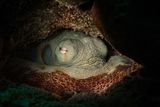
Research has unveiled intriguing insights into the sleeping habits of octopuses, suggesting they may experience dream-like states. A study published in the journal Nature details how octopuses exhibit unique sleep cycles characterized by vibrant color changes and twitching limbs, resembling those of mammals during REM sleep.
To investigate sleep patterns in octopuses, scientists focused on the species octopus laqueus. The research began with an essential step: confirming that the octopuses were indeed asleep. Through gentle prodding during different sleep phases, researchers noted that the animals required more significant stimulation to respond while asleep compared to when awake. This observation confirmed the presence of genuine sleep, with octopuses appearing white and motionless during quiet sleep, punctuated by active sleep cycles roughly every hour.
Once sleep status was established, the research team examined the octopuses’ brain activity in both awake and asleep states. They discovered that during quiet sleep, the neural activity closely resembled mammalian sleep spindles, a brainwave pattern associated with memory consolidation in humans. Though the exact function of sleep spindles remains unclear, their presence in octopuses suggests a link to learning processes.
Approximately every hour, octopuses entered a one-minute phase where their neural patterns shifted to those typical of wakefulness. Leenoy Meshulam, a statistical physicist at the University of Washington, highlighted the significance of this finding, stating, “The fact that two-stage sleep has independently evolved in distantly related creatures, like octopuses, suggests that possessing an active, wake-like stage may be a general feature of complex cognition.”
Understanding the Colorful Displays During Sleep
One of the most fascinating aspects of octopus physiology is their skin, which contains specialized pigmented cells that allow for remarkable color changes. To observe how these skin patterns evolved during sleep, researchers filmed octopuses in ultra-high 8K resolution. Meshulam noted the importance of this technique, explaining, “By filming in such high resolution, we can see how each individual pigmented cell behaves in order to create an overall skin pattern.”
Surprisingly, the footage revealed that during active sleep, octopuses displayed the same skin patterns as when they were awake. This suggests that they may be experiencing dreams that influence their skin color changes during sleep.
What Octopuses Might Dream About
The implications of these findings raise intriguing questions about the nature of octopus dreams. One theory posits that the octopuses could be rehearsing camouflage techniques, similar to muscle memory. Alternatively, the changes in their skin patterns during sleep might indicate the octopuses are reliving experiences from their day, such as evading predators or stalking prey.
Sam Reiter, a senior author of the study, added, “In this sense, while humans can verbally report what kind of dreams they had only once they wake, the octopuses’ skin pattern acts as a visual readout of their brain activity during sleep.”
This groundbreaking research suggests that complex sleep, akin to the REM phase seen in mammals, has evolved in surprising ways and may not be exclusive to mammals alone. The study opens new avenues for understanding animal cognition and the potential for dreaming in creatures with vastly different brain structures.
As scientists continue to explore the depths of octopus behavior and cognition, this research presents a compelling narrative about the rich inner lives of these extraordinary creatures, further bridging the gap between human understanding and the animal kingdom.







